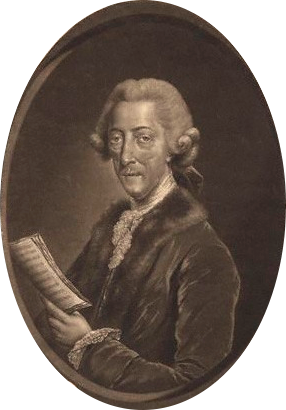
Thomas Augustine Arne was an English composer. He is best known for his patriotic song "Rule, Britannia!" and the song "A-Hunting We Will Go", the latter composed for a 1777 production of The Beggar's Opera, which has since become popular as a folk song and a nursery rhyme. Arne was a leading British theatre composer of the 18th century, working at the West End's Drury Lane and Covent Garden. He wrote many operatic entertainments for the London theatres and pleasure gardens, as well as concertos, sinfonias, and sonatas.

James William Wallack, commonly referred to as J. W. Wallack, was an Anglo-American actor and manager, born in London, and brother of Henry John Wallack.
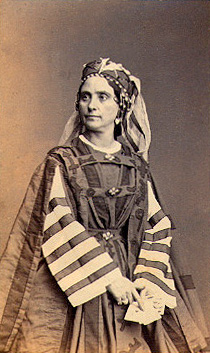
Céline Céleste-Elliott, known professionally as Madame Céleste, was a French dancer and actress who enjoyed great success on the London stage and during her four tours of America. She was also later involved in theatrical management. On her retirement from the stage she returned to Paris where she died in 1882.

The Bowery Theatre was a playhouse on the Bowery in the Lower East Side of Manhattan, New York City. Although it was founded by rich families to compete with the upscale Park Theatre, the Bowery saw its most successful period under the populist, pro-American management of Thomas Hamblin in the 1830s and 1840s. By the 1850s, the theatre came to cater to immigrant groups such as the Irish, Germans, and Chinese. It burned down four times in 17 years, a fire in 1929 destroying it for good. Although the theatre's name changed several times, it was generally referred to as the "Bowery Theatre".

The Salle Le Peletier or Lepeletier was the home of the Paris Opera from 1821 until the building was destroyed by fire in 1873. The theatre was designed and constructed by the architect François Debret on the site of the garden of the Hôtel de Choiseul on the rue Lepeletier. Due to the many changes in government and management during the theatre's existence, it had a number of different official names, the most important of which were: Théâtre de l'Académie Royale de Musique (1821–1848), Opéra-Théâtre de la Nation (1848–1850), Théâtre de l'Académie Nationale de Musique (1850–1852), Théâtre de l'Académie Impériale de Musique (1852–1854), Théâtre Impérial de l'Opéra (1854–1870), and Théâtre National de l'Opéra (1870–1873).

The Park Theatre, originally known as the New Theatre, was a playhouse in New York City, located at 21–25 Park Row in the present Civic Center neighborhood of Manhattan, about 200 feet (61 m) east of Ann Street and backing Theatre Alley. The location, at the north end of the city, overlooked the park that would soon house City Hall. French architect Marc Isambard Brunel collaborated with fellow émigré Joseph-François Mangin and his brother Charles on the design of the building in the 1790s. Construction costs mounted to precipitous levels, and changes were made in the design; the resulting theatre had a rather plain exterior. The doors opened in January 1798.

Rose Eytinge was a Jewish American actress and author. She is thought to be the first American actress to earn a three figure salary.
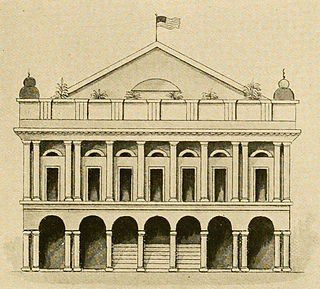
The Théâtre d'Orléans was the most important opera house in New Orleans in the first half of the 19th century. The company performed in French and gave the American premieres of many French operas. It was located on Orleans Street between Royal and Bourbon. The plans for the theatre were drawn up by Louis Tabary, a refugee from the French colony of Saint-Domingue (Haiti). Construction began in 1806, but the opening was delayed until October 1815. After a fire, it was rebuilt and reopened in 1819, led by another émigré from Saint-Domingue, John Davis. Davis became one of the major figures in French theatre in New Orleans. The theatre was destroyed by fire in 1866, but the ballroom is still used.
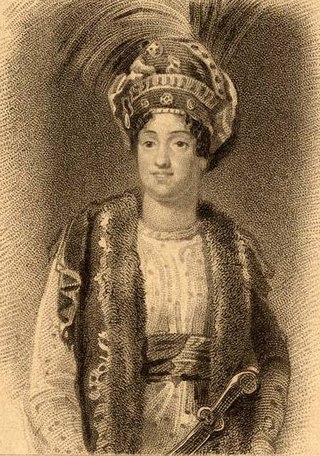
Artaxerxes is an opera in three acts composed by Thomas Arne set to an English adaptation of Metastasio's 1729 libretto Artaserse. The first English opera seria, Artaxerxes premiered on 2 February 1762 at the Theatre Royal, Covent Garden, and continued to be regularly performed until the late 1830s. Its plot is loosely based on the historical figure, Artaxerxes I who succeeded his father Xerxes I after his assassination by Artabanus.
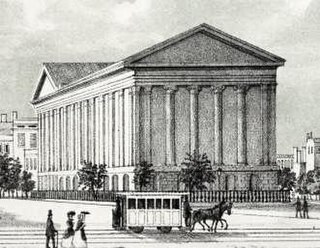
The Astor Opera House, also known as the Astor Place Opera House and later the Astor Place Theatre, was an opera house in Manhattan, New York City, located on Lafayette Street between Astor Place and East 8th Street. Designed by Isaiah Rogers, the theater was conceived by impresario Edward Fry, the brother of composer William Henry Fry, who managed the opera house during its entire history.
Sarah Wheatley born Sarah Ross was an American stage actress.
Paolo (Pablo) Rosich was a Spanish-born opera singer and librettist widely known by the Italianized version of his first name. A skilled comic actor, he performed leading basso buffo roles in many Italian opera houses as well as in Lisbon, London, Madrid and New York. Rosich created the roles of Taddeo in Gioachino Rossini's L'italiana in Algeri and Buralicchio in Rossini's L'equivoco stravagante and also wrote the librettos for two operas by Manuel García: L'amante astuto and La figlia dell' aria.

Ann(e) Childe Seguin (1811–1888) was a British and American opera singer who was part of the Seguin Troupe in America. Her best known role was as the lead in The Bohemian Girl.
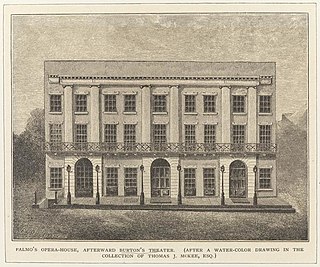
Palmo's Opera House was a 19th-century theatre in Manhattan, New York, that was located on Chambers Street between Broadway and Centre Street. It was one of the earliest opera houses in New York before it was converted into one of the earliest Broadway theatres. The theatre was conceived by Ferdinand Palmo, an Italian immigrant and successful restaurateur in New York City. It was located inside the former Stoppani's Arcade Baths building. Modest alteration to the building was done in 1843 to convert the building into a theater.
Stephen Woolls (1729-1799) was an American actor and singer, and member of the American and Old American Company.

Mrs. Edward Knight, née Mary Ann Povey (1804–1861) was an English-American singer and actress in comic opera.

Alice Oates was an actress, theatre manager and pioneer of American musical theatre who took opéra bouffe in English to all corners of America. She produced the first performance of a work by Gilbert and Sullivan in America with her unauthorised Trial by Jury in 1875, the first American production of The Sultan of Mocha (1878) and an early performance of H.M.S. Pinafore (1878).
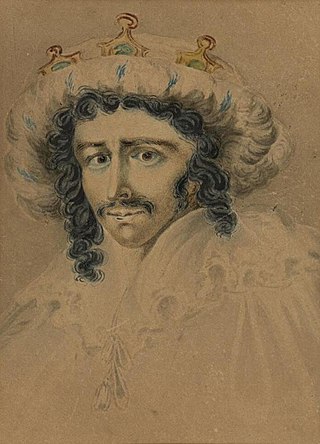
The Anthony Street Theatre was an early New York City theatre which operated intermittently from 1812 to 1821. It opened as the Olympic Theatre in May 1812 and had multiple names during its brief existence.

Julia Wildman Gould was an English-born singer and actress, who was the first woman to become a leading blackface performer in American minstrel shows.
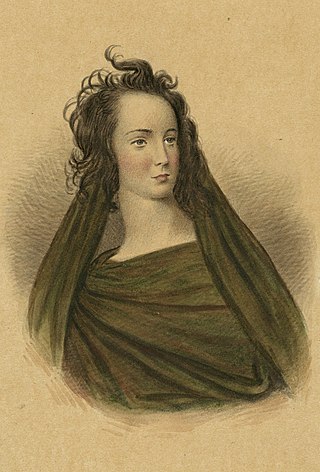
Jane Shirreff (1808-1883) was a British soprano opera singer. She was described as America's "most admired prima donna between the days of Mrs. Wood and those of Louisa Pyne".

















